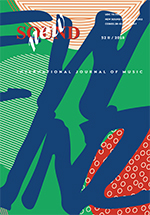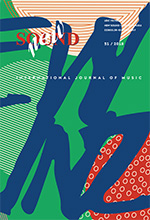Issue No. 52
70th Anniversary of the Department of Musicology of the Faculty of Music in Belgrade
Sonja Marinković – A JUBILEE OF THE DEPARTMENT OF MUSICOLOGY
AT THE FACULTY OF MUSIC IN BELGRADE
Abstract: The article sheds light on the work of the Department of Musicology at the
Faculty of Music, on the occasion of its jubilee – the 70th anniversary of its foundation.
The purpose of the text is to point out the changes that its concept of studying musicology
has undergone over the years and introduce its teaching staff and their work in research
and teaching. Special attention is devoted to the Department’s activities in publishing.
Keywords: Academy of Music / Faculty of Music in Belgrade, Department of Musicology
at FoM, musicology, music history, music pedagogy, Serbian music.
Download: ser / eng
Ivana Miladinović Prica – VIRTUAL ROUND-TABLE TO MARK THE 70TH
ANNIVERSARY OF THE DEPARTMENT OF MUSICOLOGY AT
THE FACULTY OF MUSIC IN BELGRADE (Vesna Mikić, Leon Stefanija, Ivana Perković, Dario Martinelli)
Download: ser / eng
Studies
Valentina Radoman – NEW CRITICAL THINKING IN MUSICOLOGY. What ideologies do contemporary musicologists speak from and for
whom do they speak
Abstract: New critical thinking in musicology has been new for at least thirty years and
yet it is still opposed by many musicologists or composers or performers who Adorno-like
(Theodor W. Adorno) remain devoted to the idea that the function of art in society is to be
without a function. The fact is, however, that even today such an attitude is legitimate, just
as much as interdisciplinary, critically oriented musicological research, which points out
that music, like other arts, often hides some inappropriate reverse behind its sensuous
seductiveness. Today musicologists can, based on their intellectual, educational, sensuous,
class, ethical and other potentials choose the position from which to talk about music.
Unlike traditional musicology which, according to some musicians, mostly addresses musicologists themselves, and only in ideal cases performers and listeners, today’s interdisciplinary critical musicology, in its good examples, is indispensable to everybody: art financiers (patrons or taxpayers), composers who are often victims of the market or serve
as masks behind which oligarchs hide today, performers who choose what musical works
to play and affirm and how to do it, and all listeners who are not professional musicians,
but they need to be informed about various aspects of music art.
Keywords: contemporary musicology, critical theories, critical potential of musicology,
ideologies of interpretation of music, ideologies of the perception of music.
Download: ser / eng
Pierre Albert Castanet – L’ALLEGORIE DU PALIMPSESTE:
LA MUSIQUE POSTMODERNE
EN QUESTION
Abstract: “L’allégorie du palimpseste: la musique postmoderne en question” de Pierre
Albert Castanet traite du glissement esthétique repéré dans les partitions savantes du début
du XXIe siècle dans son rapport entre les anciens et les modernes. Entre le lien souhaité
avec l’“antique” et les relations orientées vers la notion de “folklore”, cette nouvelle musique présente des signes identitaires attachés aux valeurs des ainés. Mettant à profit le
rôle de la mémoire, le musicologue français montre que la culture de “l’éternel retour” nietzschéen et les valeurs de la mixité de la World Music se réfèrent ostensiblement à une
authentique histoire sociale de l’art.
Keywords: palimpseste, postmodernité, world music, héritage, anciens et modernes,
identité artistique.
Download: ser / eng
Interpretations
Srđan Teparić – MOVEMENT STRATEGIES ASJ THE BASIS FOR CREATING
TRANSCENDENCE IN THE COMPOSITION OF THE TREE OF
LIFE BY IVANA STEFANOVIĆ
Abstract: The composition The Tree of Life by Ivana Stefanović, for string orchestra, was
written in 1997. It is composed of several entities of similar meaning, which derive from
one motif. This fact alone suggests that this composition is essentially a powerful allegory
that achieves a complex picture of the birth of human life and its development. The compositional techniques of decorating, superimposing and improvisation are powerful metaphors that indicate the flowering of living wood. From the analytical point of view, the
composition by Ivana Stefanović is interesting to observe for it avoids postmodernist
procedures. On the contrary, it is like reinterpreting the modernist idea of construction,
but tying itself to the transcendent metaphor of life. The aforementioned procedures,
which render their perpetual branching to be perceived as a single entity, lead to a com plete musical gesture that begins, matures, and ends in transcendence. The common mode
of all the procedures used in this piece is the movement that arises from one constant, a
pulsation. Musical gestures related to several strategies will be examined in an analytical
way. The first is decorating, which is directly related to similar strategies: growing, blooming and improvisation. The binding together of such situations leads to the creation of a
unique musical gesture that points to life itself. Such symbolic unity, from the beginning
to the end, has been realized in a transcendent mode. In this capacity, the composition The
Tree of Life by Ivana Stefanović stands aside from most of the usual stylistic procedures
of the time in which it was created. The combination of the strategies used points to a ludic
game of linking the pulsation, that is, movements, which stand in direct union with the
inexpressible sphere of symbolic, that is, unstoppable eternal currents.
The work deals with the analysis of strategies by which motor musical movements, as
symbols, at the signifying level, are placed as gestures of expressing the transcendent.
Moving lines and their collisions, places for creating prolongation, spreading and shrinking of the texture with the change of its layers, development of motifs with the pronounced
application of the variation procedure, all these procedures will be treated as methods of
building a unique tree of life. The composer began her narrative network with the basic
motif cell, with the first statement, “in the beginning it was [...]”. Based on the identification and method of combining the compositional strategies of the movement, it will be
possible to prove the thesis of a transcendental musical gesture, formed as a result of the
complex interrelations between the individual meaningful units.
Keywords: movement, transcendence, gesture, transvaluation, opening, closing, stopping
Download: ser / eng
New Works
Ivana Ilić – NOISE IN INNER SILENCE BY MILOŠ ZATKALIK:
THE PLACE WHERE COMPOSITION, THEORY AND
ANALYSIS BECOME ONE
Abstract: In this text the composition Noise in Inner Silence by Miloš Zatkalik is discussed from the viewpoint of transformation which, influenced by the composer’s theoretical work, took place in his creative output approximately during the last ten years. The creative process and the theoretical work are viewed as two equal, parallel and mutually
permeated domains, and the relationship between their products as two-way: the writings
are a metalanguage of the musical work, whereas the work itself reconsiders and complements, in a critical and a creative way, the theory that lies in its basis. The analytical emphasis is on large-scale goal-oriented processes in the musical flow.
Keywords: Miloš Zatkalik, goal-oriented processes, tonal center, referential sonority,
music analysis
Download: ser / eng
Analytical Perspectives
Atila Sabo – HARMONIC LANGUAGE AS A GENERATOR OF
MEDIATION BETWEEN CONTRASTING MEANINGS IN
THE POST-TONAL CONTEXT
Abstract: This paper examines the influence of harmonic language on the narrative processes in post-tonal music. The main assumption is that the phenomenon of mediation,
expounded on by David Lidov on the examples of music of Classicism and Romanticism,
is quite similarly manifested when the major-minor system is suspended. Mediation, according to Lidov, implies cancelling opposition or blurring opposed semantic categories,
which can be achieved by various music means. In music that emerged after the suspension of tonality, especially in authors who have not opted exclusively for either of the two
opposed ways of harmonic thinking, the tonal or the atonal, harmonic language remains
a significant factor in generating narratives. They play a key role in forming transitional
categories between contrasting meanings within a binary opposition, that is to say, in
emphasising the process of mediation. Departing from these views, the paper analyses the role of specific manifestations of the tonal vertical in forming meaning in the second
movement of Music for String Instruments, Percussion and Celesta by Béla Bartók
(1881–1945).
Keywords: music space, mediation, narrative, Béla Bartók, harmonic language
Download: ser / eng
Views
Nada O'Brien – WHO IS LISTENING? A PSYCHOANALYTIC VIEW ON LISTENING PHENOMENA
Abstract: A consideration of scientific research in the fields of infant observation and
psychoanalysis opens new ways of appreciating human reactions to music. The process
of evaluation and the very nature of listening are addressed. The research describes how
deeply unconscious complex reactions to music shed new light on the question of the’objective’ evaluation. Who is listening intrapsychically? Which intrapsychic content
evoked by the exposure to music lends the ear in the process of listening and renders
immediate evaluation? Exploration of the interplay between developmental and archetypal dynamics in connection with music flow invite new perspectives.
Keywords: music, psyche, listening, development, mirroring, coenesthetic experience,
unconscious, archetype.
Download: ser / eng
Research and Tradition
Milica Gajić – MARKING THE JUBILEE OF THE NATIONAL THEATRE
IN BELGRADE: 150 YEARS SINCE ITS FOUNDING (CZECH
MUSIC AND MUSICIANS ON THE STAGE OF THE NATIONAL
THEATRE IN BELGRADE UNTIL 1914)
Abstract: This year’s jubilee of the National Theatre in Belgrade is an opportunity to
remind ourselves of the presence and contribution of Czech musicians at that institution.
We meet them as members of the orchestra, bandleaders, authors of operas, operettas, and
stage music, and, to a lesser extent, as vocal soloists in numerous works of stage music
and chamber musicians. Many of them showcased their concert activities on the stage of
this institution, including even some who were internationally renowned musicians at the
time.
Keywords: jubilee, National Theatre in Belgrade, Czech musicians in Serbia, stage-music
works, Serbian music
Download: ser / eng
Reviews
Ivana Miladinović Prica – Ana Kotevska, Isečci sa kraja veka.
Muzičke kritike i (ne)kritičko mišljenje
(1992–1996) (Fragments from the Turn
of the Century: Music Criticism and
(Non-)Critical Thinking, 1992–1996),
Banja Luka–Belgrade: Besjeda, Clio,
2017, 223 pp. ISBN 978-86-7102-571-3
Dowload: ser / eng
Predrag I. Kovačević – Dragan Latinčić, Spektralna
trigonometrija – zasnivanje univerzalne
muzičko-metematičke analize, (Spectral
Trigonometry – Establishing a Universal
Musical-Mathematical Analysis),
Beograd: Zadužbina Andrejević, 2017,
164 pages, ISBN 978-86-525-0299-8
Download: ser / eng
Marija Golubović – An Introduction to Serbian Performing
Arts Education (Critical Insights).
Collection of Summaries, Evangelos
Himonides and Vera Milanković (eds.),
London: iMerc, 2017, 191 pages,
ISBN 978-1-905351-32-9
Download: ser / eng
Ivana Nožica – The World Youth Concert Scene
The 68th Festival of Young Artists in
Bayreuth
Download: ser / eng


